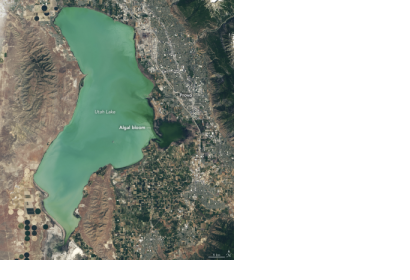Harmful algal blooms endanger the health of both humans and animals through poor water quality and can cause economic loss to coastal communities. Such algal blooms are composed of an excess of cyanobacteria, which becomes dangerous when subjected to certain conditions, such as extended sunlight exposure, stagnant water, and the increased presence of various nutrients from fertilizers. Under such circumstances, cyanobacteria aggressively multiply, causing water to have a viscous, green appearance, discernible from space. The unique perspective from Earth-observing satellites by NASA and its partners facilitates the study of the relationship between water and other Earth systems, as well as addresses its consequences, especially on water quality.
The striking green color of algal blooms is caused by chlorophyll-a, a photosynthesizing pigment in cyanobacteria. Scientists can estimate the quantity of cyanobacteria in a body of water through satellite measurements of the concentration of chlorophyll-a within the water. NASA’s Terra and Aqua satellites, along with the joint NASA/USGS Landsat satellites, and the European Space Agency’s Sentinel-2 and -3, track algal blooms, depending on their ability to capture a clear image at the right time, free of cloud interruptions. In complement to these satellites, NASA will launch Landsat 9 in 2021 to support the observation of algal blooms.
The Cyanobacteria Assessment Network (CyAN project), composed of several agencies, including the Environmental Protection Agency (EPA), the National Oceanic and Atmospheric Administration (NOAA), the U.S. Geological Survey (USGS), and NASA, monitors harmful algal blooms, along with other water quality concerns, from space and is developing an early warning indicator system.
Fertilizers are an indirect cause of harmful algal blooms, as they contain many nutrients, including phosphorous, which can lead to undesirable plant growth. This, in turn, can harm ecosystems far away if the agricultural runoff pours into river, lakes, or coastal waters. The affected ecosystems are fundamental for aquatic life and are sources of drinking water for human populations. The effect of fertilizers on distant bodies of water, and subsequently on natural and human life, illustrates the connectivity of Earth systems, as waterways bind together areas that are thousands of miles apart.
Especially prone to economic loss resulting from harmful algal blooms is the healthcare sector. A study, funded by NASA, revealed that early detection of such algal blooms resulted in fiscal savings in healthcare. Focusing on a 2017 algal bloom in Utah Lake, the study compared the real-life scenario, in which satellites quickly detected the bloom, and a speculative scenario, in which human observers and on-site testing determined the ensuing decision. In June 2017, Utah public health officials posted well-timed warning signs based on early satellite data detection, alerting guests not to swim or water ski, to be careful while boating, and offering safety recommendations for fishing. In the speculative scenario, officials conversely waited one week before placing the warning signs, while human observers first reported on the bloom and then confirmed it with on-site testing. Scientists estimated that such a delay would have cost $370,000. The results of the study demonstrate that early detection of harmful algal blooms is economically crucial.
Taking advantage of the more frequent re-visit time of satellites, environmental and health officers now benefit from the use of satellite technologies to track the spatial and temporal evolution of such harmful algal blooms.

